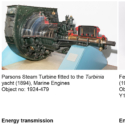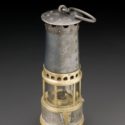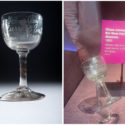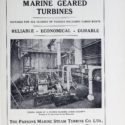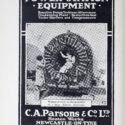Energising connections in museum collections
Article DOI: https://dx.doi.org/10.15180/221804
Abstract
The task of inter-connecting artefacts within the broad category of ‘energy’ across multiple heritage collections raises very significant challenges. Energy per se is itself invisible, manifested only in a bewildering diversity of technological mediations of its acquisition, storage or transformation from one form to another (e.g. chemical to thermal, or electrical to motive). And while energy usage via such technology is easily linked to industrial growth and global prosperity, it is also entangled in multiple stories of human and environmental destruction over many centuries, albeit unevenly distributed over social class and global location. How then can the Congruence Engine project draw some coherent stories together from heritage collections that hold energy-related artefacts of so many kinds? Our paper explores how the Congruence Engine’s Energy team will approach this task by taking as our starting point two specific collections of Newcastle’s Discovery Museum: steam turbines and coal mining. Focusing on that particularly convenient pair of preliminary case studies enables us to look ahead to how we can bring the Congruence Engine project’s digital humanities tools more fully to bear in linking such energetic heritage to other (at least part) digitised collections of films, photographs, songs and journals, etc. In so doing, we highlight the need to address the broader cultural landscape of energy, often involving emotional human stories, that bring meaning to museum audiences’ engagement with energy’s material culture. And in contrast to traditional museum narratives of energy history as the technocratic ‘conquering’ of nature, we consider how the Congruence Engine project could help to bring in a complementary approach: memorialising energy history instead as a human drama entangled with many forms of human loss.
Keywords
coal, disaster, energy, film, heritage, miners, Museum, Newcastle-upon-Tyne, song, steam
Introduction
https://dx.doi.org/10.15180/How can we interconnect the UK’s museum collections on energy heritage into an integrated, searchable resource? The Energy strand of the recently launched Congruence Engine project aims to do this during the course of 2023 by using the affordances of digital humanities techniques.[1] This paper lays out a theoretical framework for energy humanities in which such a digital humanities project will be conducted. To make this task viable in at least a few well-developed case studies, the project will work with a limited range of primary UK museum partners: the Science Museum group, Discovery Museum in Newcastle, and National Museums Scotland; more informally it will work with Birmingham Museums Trust, National Museums of Northern Ireland and National Museum Wales. It is to these organisations that we have looked initially to supply collections records on energy artefacts. Initially we aim to target two areas in the collections that are most strikingly prominent in our lead museum organisation at Newcastle: Parsons’s steam turbines and coal-mining accidents – topics more intimately connected than one might initially suspect. To bring cultural depth to our digital intermediations, we will link to resources held by our other formal project partners – photographic records held by Historic England (formerly English Heritage), and cinematic reels held by the British Film Institute (BFI).[2]
The key question is: how best should we go about intermediating such geographically dispersed energy-based collections with the techniques of digital humanities? We offer an answer in three parts: the overall challenge of scale, the kinds of resources available for a humanly engaging resource, and the existential threats to consider if the climate crisis renders irrelevant such meta-level discussion of energy heritage. First, we explore the extraordinary diversity of museum artefacts pertaining to energy; then we look at the multiple kinds of heritage/cultural resources that can bring in human voices to meaningfully interpret the social role of this material culture. Finally, we consider the overall museum trajectory of energy artefacts in the Anthropocene to enquire how these might have reflected, or indeed contributed to, the climate-energy crisis by their celebratory narratives of energy transmutation and consumption. Overall, by developing new sorts of intermediated energy heritage narratives, the Congruence Engine’s Energy theme aims to help museum partners present to their audiences new historically informed ways to rethink energy consumption practices into a more sustainable form.
The heterogeneity of energy heritage
https://dx.doi.org/10.15180/221804/002Of the three themes to be explored consecutively in the Congruence Engine project – Textiles being the first and Communications the third – Energy is arguably the most ubiquitous in daily life and in museums of science, technology and industry – and yet also the least directly visible. As a highly mathematical abstraction of modern science and engineering (Coopersmith, 2015), energy is not so easily amenable to the sort of material exemplification as a piece of fabric (Textiles strand) or a telephone cable (Communications strand).[3]Energy is rather a second-order phenomenon, important for what it makes possible for human purposes in collectable heritage artefacts rather than what it is in itself, both invisible and immaterial (except perhaps at the quantum level). Energy is thus manifested materially only in specific instances of objects designed for harnessing natural resources for specific goals – whether for extraction, storage or quotidian usage.
In the UK’s museums, energy collections range across multiple forms of industrial heritage: steam engines, batteries, coal mines, nuclear power stations, electric cookers and many more besides. Even those cannot necessarily be easily displayed in museums or heritage sites on the grounds of sheer size (power stations) or toxicity (nuclear power) or sheer dullness (who would learn much by staring at a vat or pile of raw fuel?). More important is to understand the hugely eclectic and disparate kinds of energy technology in our museums and the several major points that are pertinent to energy growth and security.
One approach to understanding the diversity of museum artefacts in energy might be to divide them into the three traditional economics categories of energy extraction, energy transmission and energy consumption. That three-fold division is laid out in the three images of Science Museum equipment holdings shown below in Figure 1.[4]
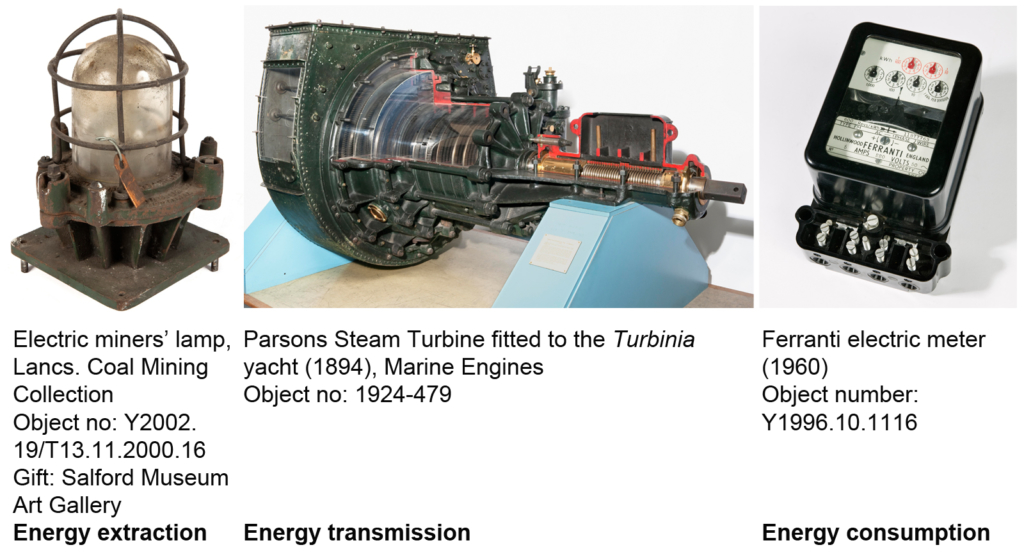
This static tripartite demarcation into extraction, transmission and consumption does not, however, do justice to the broader interconnections within and between them as long ago highlighted in Thomas Hughes’ classic systems-based methodology of understanding the history of electrical energy supply (Hughes, 1983). More broadly, the significance of energy’s material cultures can best be understood not just (as traditionally) by the ingenious inventiveness and technical skills that they embody in fixed categories of origination but by their broader interconnections to many other objects in human usage activities (Oudshoorn and Pinch, 2003). It is, after all, well-recognised in science and technology studies literature, which has rejected naïve forms of technological determinism, that it is the very human usage of technologies that recurrently leads to new demands and expectations, as well as innovations (Ibid). The market-based user-shaped trajectories in the evolution of energy artefacts is part of the reason for the non-convergence of their designs into a multiplicity of forms. Given this diversity of material heritage in the energy domain, the Congruence Engine’s Energy project team needed to select specific themes to focus effectively on the most crucial aspects for interpreting energy’s past and future prospects.
We suggest that reasons for the sheer diversity of energy material culture include the following:
i) Industrial/economic growth leads to relentless innovation
We can easily map a long succession of energy techniques emerging in a Neolithic world, ranging across wood fires, food supplies and animal power, and probably both developed and used in conjunction (Crosby, 2006). But with social and industrial growth, exhaustion occurs in succession: wood technology increased then replaced by coal, then oil, gas, nuclear, green renewables all entering the market as competing alternatives. No honest energy narrative in a museum could be without all of these to represent the changing forms of energy usage. One longue durée narrative of energy in industrial society is thus of ever greater growth in population and demanding human usage repeatedly outstripping supply; this has entailed ever more risky and unsustainable approaches being used to secure fuels – mining or atomic fission being standard examples, and a long series of new technologies in supplying energy on an ever greater scale, older versions of which might be discarded and/or venerated in often aesthetically-driven ways. In part then, the sheer array of past energy technologies in museums is thus a tribute to the continuous growth of energy usage that has engendered climate change in our lifetimes (more on that in our conclusion).
ii) Energy security requires diversity in multi-stage processes in industrial eras
Ours is not just a story of displacement: another reason for the diversification of energy artefacts is the often fraught issue of energy security. So utterly dependent is industrial society on a regular, immediate and high-intensity form of energy supply for domestic and commercial purposes, that it needs that energy supply to be unperturbed by interruptions or uncontrolled variations. Critically reliant on sophisticated systems of delocalised energy supply (typically electrical), business and homes cannot risk any substantial supply breakdown, a back-up plan has clearly become essential. Initially for modern grid power stations, the capacity to work from any fuel – coal, oil or gas – was a strategic move to avoid over-reliance on any single fuel supplier, with candles and storage battery power used when the Electricity Grid has, nevertheless, failed. On a broader canvas, coal and gas generation are still typically the options used to cope with surging energy demand; conversely nuclear power has often been cited as a means of coping with (geopolitical) fluctuations in the availability of fossil fuels.[5] While having multiple concurrent supply options might appear inefficient, it is the inescapable corollary of living in a world that cannot wait upon the contingencies of sunshine or wind-power; our heritage collections of energy consequently reflect this concurrent diversity of technology (Yergin, 2011).
iii) The commodification of specialist energy usage technologies: the domestic revolution
Finally, the sheer diversification of energy usage in the so-called ‘domestic revolution’ from the 1920s to 1970s has of itself generated an astounding amount of electrically powered household equipment: bread makers, kettles, vacuum cleaners, etc. These devices were barely needed a century ago – electric lighting was for most the primary use of domestic supply in the earliest decades of electrification, and as Gerrylynn Roberts points out, British householders initially treated only the electric iron as more useful than its pre-electric counterpart in the 1920s/30s. Her suggestion is more that the purpose of domestic diversification was to increase daytime consumption of electricity so as to make the sunk-capital of generating technology more profitable for supply companies – irrespective of whether it saved any household labour (Roberts, 1989, 94-108). In our partner museums’ heritage collections and their cultural correlates, our project can indeed see how far museums in the past were complicit in industrial sponsorship of energy exhibitions to increase demand for electrical products – or occasionally, for example in wartime, to instead ration domestic fuel consumption to divert energy into war production (Harrison Moore and Sandwell, 2021).
Faced with this huge domain of complexity, we have decided to take a pragmatic move and focus initially – as a pilot project – on two of the most humanly significant category holdings in Discovery Museum. One is the Parsons’ steam turbine, a radical industry transforming innovation of the 1880s which increased the efficiency of power generation up to nearly fifty per cent – more than twice as efficient as the highest-tech reciprocating steam engines (Leggett, 2011). Traditionally the steam turbine has been interpreted as Tyneside’s local story of heroic innovation, most famously in the high speed Turbinia of 1894, a small ship displayed dramatically at Discovery Museum’s entrance. We can, however, aim to use digital humanities methods to move beyond such local stories and map how the Parsons turbine replaced the reciprocating steam engine in almost all power stations around the world by the time of Charles Parson’s death in 1931. Not only a story of internationally networked invention, this is a story of how museums in an era of climate change can beneficially highlight innovations in energy efficiency. This can complement the strikingly dynamic representation in Living With Machines – currently exhibiting in Leeds City Museum – of historical growth in energy extraction, production and consumption in individual cities (Living with Machines, 2022).[6]
Turning then to the supply side of electrical power, the need for greater efficiency in generating technology epitomised in the Parsons turbine was linked, in fact, to a second broad energy theme: the increasing challenges of extracting fossil fuels in the late nineteenth century. In coal miners’ heritage we can see this manifested in the consequences of greater demand for a fuel that was becoming ever more challenging to extract economically. The efficiency challenge in this extractive industry arose from the way that coal mining became less economic as colliers (at a given site) had to dig ever deeper into the bowels of the Earth, with greater attendant risks for miners working miles below the surface. Such risks engendered greater use of safety lamps by miners, many of which were bequeathed to museums for posterity by the families of those miners lucky enough to survive the increasing perils of mining to the end of their careers. For the tens of thousands of UK coal miners who died in their work, various melancholic forms of memorialisation can be found among mining heritage collections. In our discussion of Discovery Museum, we thus examine both its collections of miners’ safety lamps, and also a poignant collection of ‘Disaster glasses’ that both beautify the memory of lost miners and remind us of the ugly fate of so many hard-working coal hewers.
Energy heritage proliferation in the collections
https://dx.doi.org/10.15180/221804/003The extraordinary quantity of energy heritage collections is apparent when we look at our museum partner’s holdings on the above two topics alone. While National Museums Scotland in Edinburgh records only 84 results for ‘steam turbine’, for coal mining there were 1,162 related items – an order of magnitude greater.[7] The Science Museum in London records a similar number – 1,225 – of coal mining objects but it hosts no fewer than 1,853 steam turbine artefacts.[8] So given such collection sizes readers will readily see how even with the Congruence Engine’s Digital Humanities Methods, we cannot hope to understand and exhaustively interpret all of the very large and heterogenous energy collections that the project is thus bringing together. Our specific, narrower aim it is to create a limited array of new multimedia narratives to attach human meaning to a few case studies of energy stories with constraints: the Parsons turbine heritage from the 1880s to 1930s, and the small subsection of coal mining collections that relates to accidents and danger. To give human meaning to these stories we aim to use material available at other partner heritage organisations, including films, photographs, sound recordings, songs, poems, journalism, autobiography and oral history.
Ideally these would be linked to museum artefacts by automated machine learning from fully digitised collections, as accomplished in the aforementioned Living with Machines project. Anticipating, however, that many heritage collections will not be sufficiently digitised for full automated intermediation, the aim will be more commonly for ‘hand-stitched’ connections wrought by the human judgement of informed curators, museum volunteers and historians of various kinds. The choice of initial specific themes for this enterprise – steam turbines and coalmining accidents – is discussed in what follows. But importantly, this contrasts with some previous energy-related projects in which new cultural resources were fully co-created with external communities, specifically dramatic and pedagogic techniques used by Gooday and colleagues for AHRC Electrifying the Country House and AHRC Electrifying Women to bring past stories alive.[9] The strict discipline then of the Congruence Engine is to get other extant collections to speak to our partner museum’s artefactual energy heritage, leaving to a later stage the full process of public engagement.
In pursuing this integrative goal, two new interpretive points might emerge that are important for curators and museums-based scholars. Comparative study of documentation on institutions’ collections development policies, as well as the tracking of kinds of energy-related objects in those institutions’ collections, might enable us to discern whether past collecting approaches effectively privileged certain kinds of energy artefacts and narratives over others; that approach could establish at least what (in quantitative terms) are national strengths in our energy-related collections and (ideally) develop dynamic maps of the distribution of artefacts geographically over time, as accomplished by the Living with Machines project. Conversely, from these collective endeavours we might also identify quirky and exclusionary tastes in past collecting policies on energy artefacts – if there were policies at all – that have left us often idiosyncratically-constituted assemblages. By implication then, the project will also supply scope for identifying the missing voices and objects in museums that are needed: interpretative narratives that are both more inclusive in the human perspectives they offer, and also more geared to a longer-term vision of how energy consumption relates to climate change issues.
Will the above-mentioned museums’ collections accurately reflect the vast complexity and diversity of energy usage across the three domains mentioned in the first section above? This seems on the face of it unlikely: there is no prima facie reason to believe that energy artefacts will have been collected or deposited systematically in museums in any directly representative way. The common rationales for deposition might instead have included heroisation of local individuals; the preservation of local stories; and the acquisition of discarded obsolescent equipment. There are several other key possibilities: dysfunctional or obsolescent devices could be – and were more often in past generations – recycled into newer hardware; a reincarnation process that completely bypassed the museum locale. Others might have been disposed of in part or as a whole as rubbish, or in some cases – where the resources or opportunities were insufficient – were just abandoned in situ as a (rusting) relic. In the course of the Congruence Engine Energy team’s investigations into the patterns of collecting, answers to such questions may well emerge over the next year.
The example of the steam turbine is revealing in this regard. Of the thousands made and installed since its inception in 1884 by Charles Parsons, many continue to work invisibly inside marine vessels (ships, submarines) and power stations and in their descendant, the jet engine. So large can these turbines be, it appears from our preliminary investigations with Congruence Engine partners that museums typically will not hold more than a few specimens of full-size turbines. One exception to this in the early 1930s is that the Science Museum in London displayed no fewer than six different kinds of steam turbine as a marker of Parsons’ technology being a major British/Irish technological success; suffice to say that rather fewer of these are on display in the Science Museum today (Appleyard, 1933, pp 317–321). However, now a museum visitor would be more likely to find that an array of educational turbine models and disassembled component parts will be displayed since these are rather easier to use to communicate turbine operations than a full-sized relic – unlike the mesmerising reciprocation of a Newcomen or Watt steam engine, the relentless spinning operations of Parsons turbines are shielded invisibly (and safely) out of sight, and thus less organically intuitive to most museum audiences.
Fortunately for our project, Tyne & Wear Archives volunteer Geoff Horsman, a former employee of Parsons (and its successor Siemens company from 1997), has an extensive knowledge both of the engineering operation of successive models of steam turbines and also of many decades of Parsons company heritage in Tyneside, both in the Museum and elsewhere.[10] From his exploration of the vast archival resources of technical documentation and photographs, we know a great deal about the fate of many turbine installations, and in a few cases about their disassembly. Only a relatively small proportion of historic steam turbines have survived; indeed, at least some machines were destroyed in fatal explosions involving turbines and were thus scrapped as being beyond repair. Sadly we know also that the Parsons turbines installed in the SS Titanic (sunk 1911) and Britannic (sunk 1916) are now rusting relics on the seabed off the coasts of Canada and Greece respectively. Unsentimental digital analysis of their remains continues to fascinate many, alongside the rusting relics of more traditional reciprocating steam engines (Encylopedia Titanica, 2020; Titanic Enquiry).
The sad fate of those two irretrievable Parsons turbines points to a more obvious major consideration in museum acquisitions. Where objects could be retrieved or retained as remnants of a mechanical disaster, a strong sense of emotional attachment to them was apparently what prompted their accession to museums. The extent to which objects too valuable in their biographical import to be sold or discarded were instead donated to a museum for public commemoration is open to further investigation as the Congruence Engine maps the collections of energy artefacts and the documentation that accompanies them. This will be an especially important point as we consider safety lamps among the large number of coal mining artefacts.
What do mining collections show us? Overwhelmingly miners’ lives flourished beyond the industrial disputes and strike action that have understandably dominated labour history drawing primarily from trade union history; workers’ histories have long aimed to tell us how much miners’ lives were about surviving the perilous circumstances of their labour (Working Class Movement’s Library, 2022). A key point here is the substantial collections of coal miners’ lamps – usually known latterly as ‘safety lamps’ – that are held by our partner museums. While some were evidently donated in their original form by manufacturers, and are thus in pristine condition, systematic donations of lamps in a less pristine condition are also apparent. Other lamps had been donated from enquiries that no longer needed to keep their specimens, for example from the Royal Commission on Accidents in Mines, 1879–86 (see below). However, at least some lamps in the Discovery Museum collection that showed signs of extensive wear and tear were family donations to commemorate the lives of miner kin who had survived colliery work to enjoy some kind of retirement. The intact extant lamp’s survival was the key correlating evidence of a human life lived, with further suggestions to research further that such lamps were also used as memorial lights in the homes of deceased miners prior to the lamps’ deposition in museums.[11] [12]
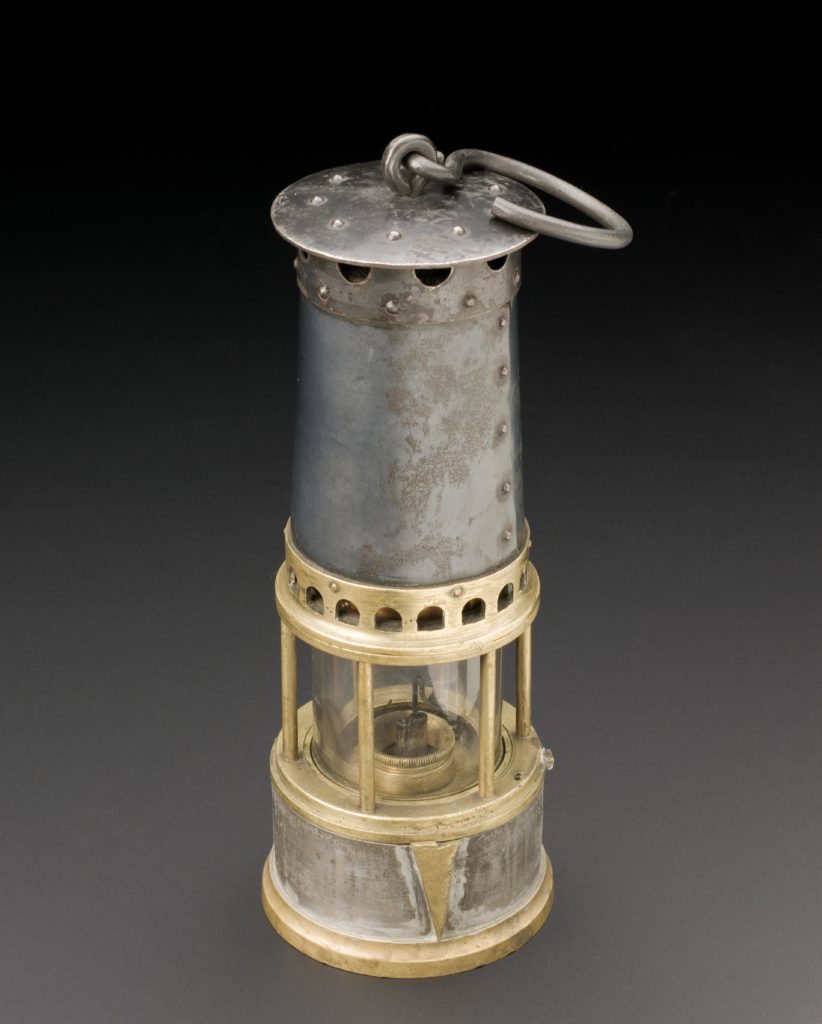
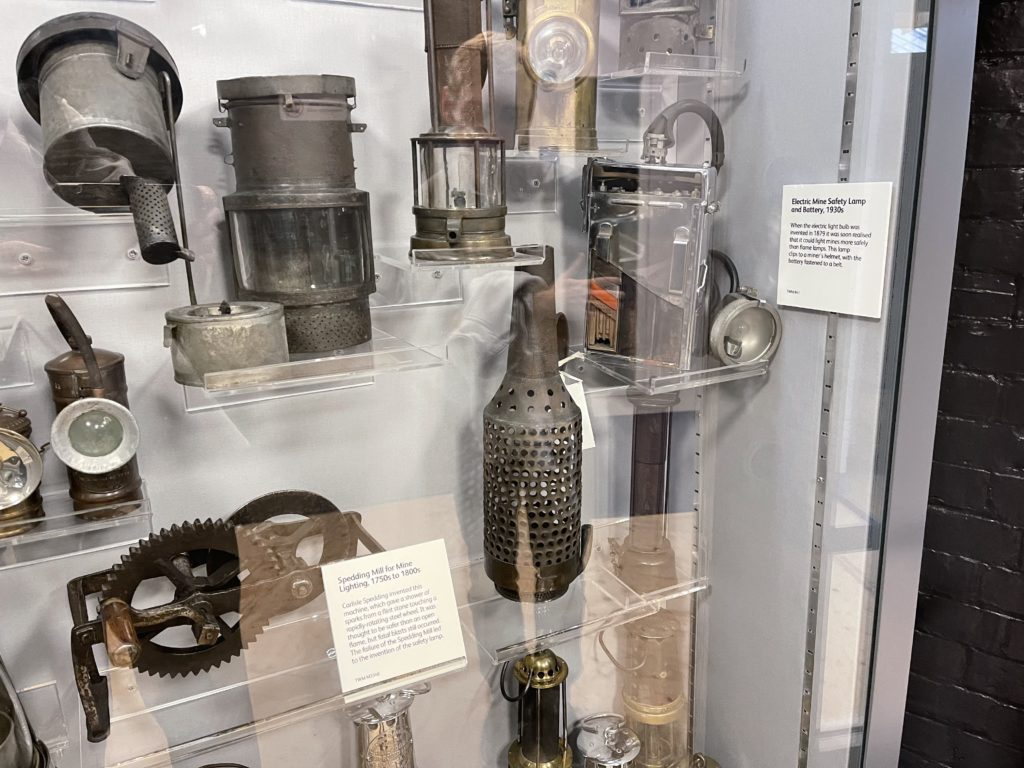
Yet the most touching artefacts in such museum memorabilia related to colliery disasters that marked the many lives lost in coal mines. In the UK alone this has been documented at 85,000 deaths between 1873 and 1953 and as many as 1,800 in a single year, with at least 164,000 coal-mining fatalities documented since 1600 (North of England Institute of Mining and Mechanical Engineers, 2016; Paxman, 2021; Coalmining History Resource Centre, 2021). Each locality in the UK had its own particular way of memorialising these colliery disasters in tangible relics that would sustain the memory of the lives lost. In Tyneside, the most common form of commemoration was known informally as the ‘disaster glass’ – a delicate piece of vitreous artistry with the key dates and location inscribed. For example, the Discovery Museum collections contain a commemorative glass relating to the Hartley Colliery Disaster in Northumberland on 16 January 1862, in which 204 miners died (including child workers) (Co-curate, 2021). See below for an image of this, indicating that these glasses were sold to raise funds for the families of those killed in the mining accidents.
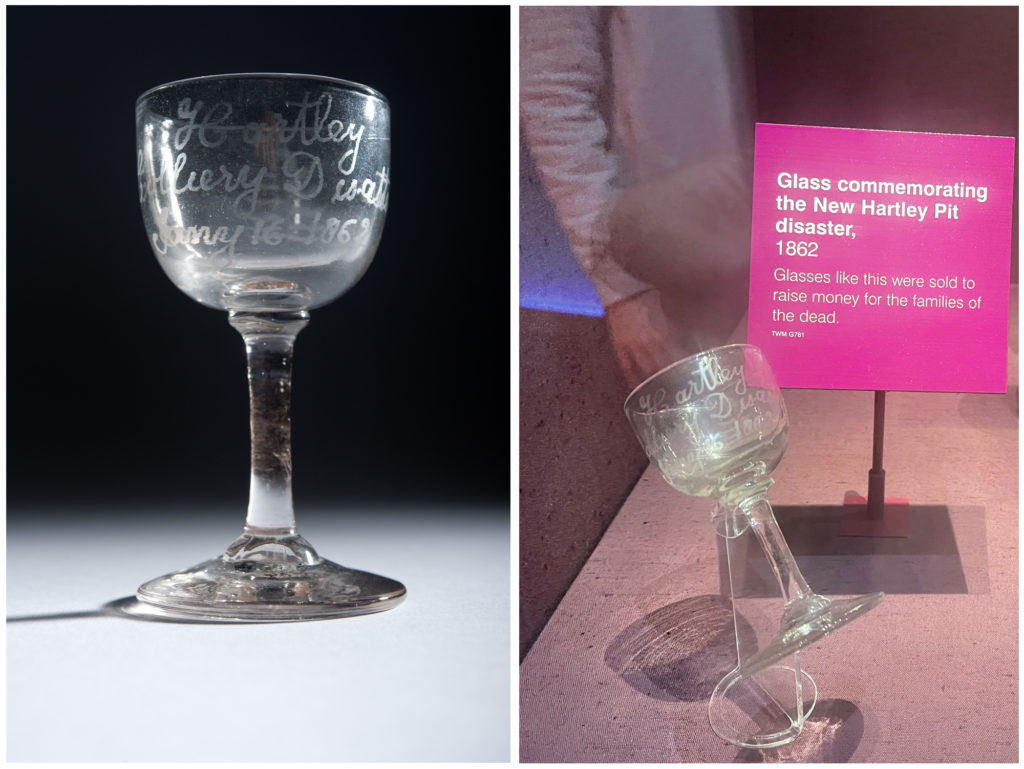
Looking at the status of coal miners’ heritage in the light of their sacrificial tragedy in bringing coal to the surface yields fresh scope to escape the paradigm of James Watt the steam inventor and Industrial Revolution paradigm that has long dominated museum interpretations (Russell, 2019; Science Museum). We argue instead that the Congruence Engine can more productively focus on the coal miners who powered that ‘revolution’ and Watt’s lucrative fame.
Let us turn next to the kind of resources that might enable us to tell stories of an appropriately emotional tenor for energetic artefacts.
Communicating cultural stories of energy
https://dx.doi.org/10.15180/221804/004Stories of innovation in energy usage can be full of drama and excitement. In the history of the Parsons steam turbine, the story of the Turbinia ship and its startling speed trial in 1894 is captured well in Discovery Museum’s displays, as indicated in the promotional photograph below.[13] Our Congruence Engine Energy blogpost showed Turbinia in full flight as well as some more sedate decontextualised examples of stationary turbines (Gooday et al, 2022).[14]

But to move away from conventional individualist heroic narratives of invention, we need to consider what resources there are in partner organisations to highlight the contribution of Parsons’ co-workers in developing turbines. Internal to Discovery Museum there is a small amount of archival material at Tyne & Wear Archives featuring the experiences of some Parsons workers who collaborated with both Charles Parsons and his spouse Katharine. Consider, for example, the reminiscences of long-term assistant Frederick Gordon Hay Bedford from 1901 to 1961.[15] Bedford started as an apprentice in 1901 noting that Parsons ‘had the knack of making unlikely things work’ but was ‘not the easiest of men to get on with’. There were clear indications of Parson’s secretiveness: ‘I remember on one occasion when I wanted to see some details drawing to discuss some weak point in design, the assistant engineer who showed it to me, covered it all up with a sheet of paper and would only let me see that part being discussed, the suggestion being that everything at Heaton was secret, private and confidential;’ however, ‘things changed greatly and towards the end of his life Parsons and I became the best of friends.’[16]
In 1904 Bedford became the Parsons company Secretary’s Assistant, realising that this was more suitable than an engineering role, and was promoted to Company Secretary in 1910. Once in that position, Bedford recalled that Sir Charles and his staff were much closer: ‘Parsons and Katie…were exceedingly kind to me, and though both, perhaps in different ways, were a little difficult, they could not have been better friends.’ Both Charles and Katharine attended ‘many social events’ with the company, but ‘shunned all forms of publicity’ so there was little naming publicly of company buildings after the Parsons family.[17] Instead at their homes in Holeyn Hall and Ray, Bedford saw many distinguished visitors, engineers, scientists, etc. networked and entertained.[18] From this we can see how the wealth gained by the Parsons family from the turbines business, as well as his aristocratic family connections, made possible a great local reputation and national reputation for the Parsons name – even as they shunned any celebrity status of the sort cultivated by James Watt a century earlier (Russell, 2019).
The Parsons family wealth also helped to create a more conspicuous resource that would be of more direct value to the Congruence Engine Energy theme’s work in intermediating cultural associations. A valuable and partially IET-digitised external resource on the Parsons family and its machinery is The Woman Engineer.[19] This was and still is the journal of the Women’s Engineering Society (WES) – both the Society and the journal were founded in 1919 by Lady Katharine Parsons and her daughter (with Charles), Rachel Parsons. These institutions were strongly supported by both the female Parsons, and Charles Parsons too, drawing upon the enormous wealth secured from the Parsons steam turbine business (Heald, 2019, pp 71–90). The journal pages were especially well supported with many an advertisement for Parsons products for the first six years when either Katharine or daughter Rachel Parsons was WES President. Specifically from spring 1921, this quarterly journal often held advertisements for Parsons technology, almost all showing turbines and other generating machinery being assembled by a younger Tyneside female workforce:[20]
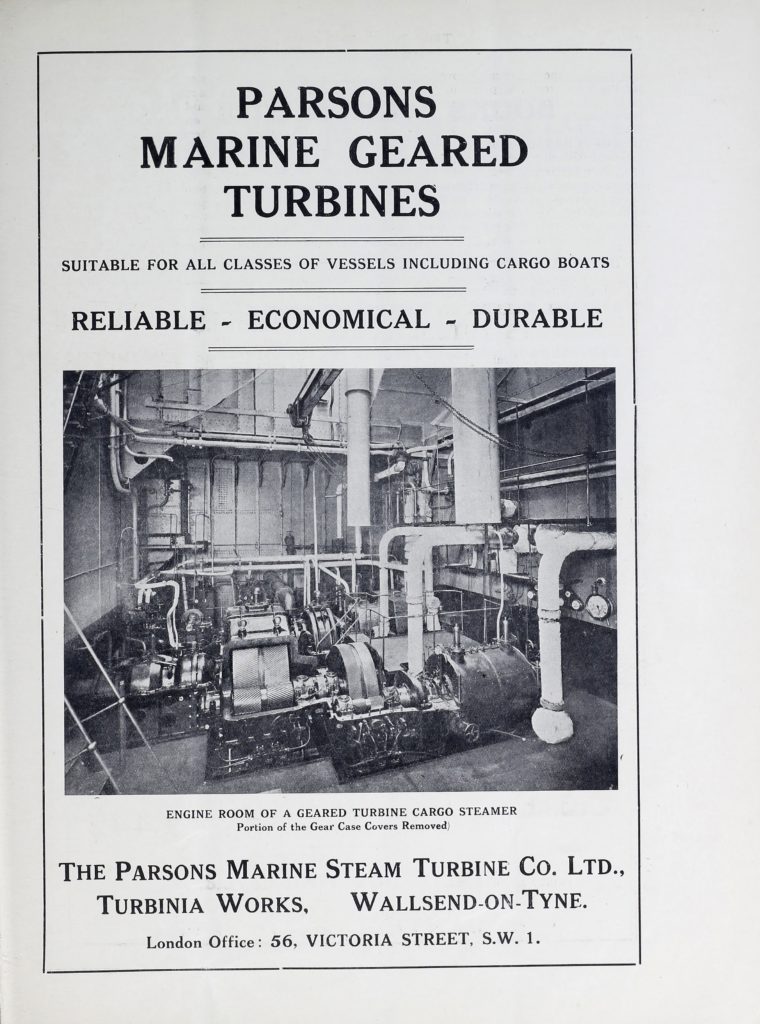
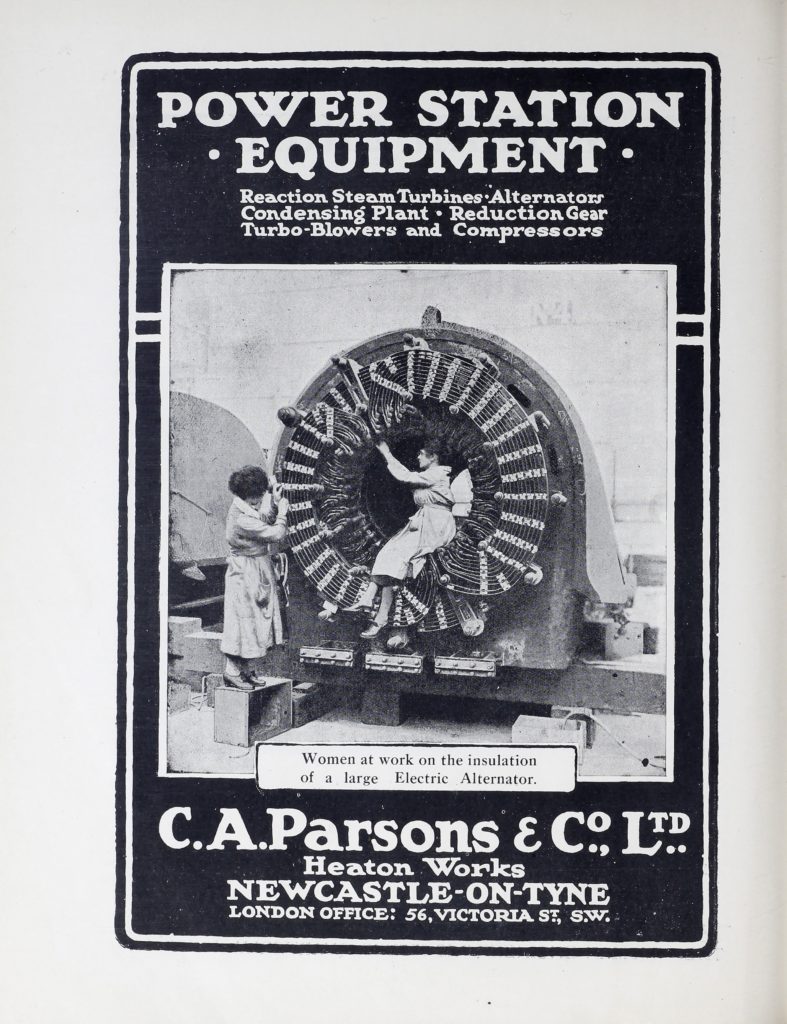
Extending further beyond the Parsons company’s own resources, we can look to the semi-digitised photographic resources of Historic England. There are many images available there of British power stations – exterior and interior (some historic, some contemporaneous) – almost all of which would have containing Parsons turbines. These have been carefully curated by co-investigator Wayne Cocroft, including those concerning power stations that no longer exist – as mapped and recorded, for instance, in Historic England’s extensive database.[22]
ii) Mining – numerous films exist which capture at least something of the past working lives of miners, a welcome distraction from later twentieth century views inflected with industrial relations disputes and climate change blame games. For example, the early silent film A Day in the Life of a Coal Miner (1910) gives a view of the surface life of a colliery, without being able to light or enlighten what is not so visible below in the mine shafts (Russell, N D).[23] For our purposes it is important to focus more on the accidents – or at least risks thereof – as part of the increasing challenge of technology and human skill pushed to its limits, thereby to understand the world of the disaster glasses that Discovery Museum has in its collections.
In fact the miner-made film Black Diamonds (1932) – borrowing the title from earlier films – directed by Charles Hanmer, a former miner, is an early ‘talkie’. Although elevated by a certain meta-level self-awareness in its plot focused on a miner making his own film about trying to secure funding to make a film to draw attention to the dangers of mining, the overall effect is clearly to highlight how dangerous the practices and consequences of mining could be – and not just for miners. In fact, this film uses both direct footage of real working miners as well as dramatic sound and visual effects to bring home the risks of mining, with a touching authenticity as it is based on the real-life pit disaster at Cadeby in West Yorkshire in 1912. Further films exploring the dangers of pit life are Blue Scar (1949), a Welsh quasi-feminist study of coal nationalisation focused on the female perspective,[24] and The Brave Don’t Cry (1952) about a Scottish mining rescue team based upon a genuine 1950 coal mining disaster.[25] Also important to mention in BFI collections is The Stars Look Down (1940), which covers the issue of a feared mining disaster that comes to pass through corporate ruthlessness.[26]
While these are representations of coal mining and its dangers from the point of view of the film industry informed by some genuine mining expertise, a more authentic source of miners’ own emotional encounter with the risk of injury or death is arguably their songs. One such famous song, illustrating a child’s pre-vision of a colliery catastrophe is ‘Don’t Go Down The Mine, Dad’, was not only widely sung but was turned into a series of postcards and a magic lantern display in the pre-cinema idiom of the 1890s.[27] Most poignant of all is ‘Gresford’, still performed widely in the UK’s mining world, which relates to a disaster on 22 September 1934 at Gresford Colliery, close to Wrexham in north-eastern Wales, in which 266 miners’ lives were lost.[28]
Looking at such narrative auxiliaries, we need to ask which human stories can be recovered from the juxtapositions of these resources that can speak effectively to present-day museum audiences? Should we focus on narratives of workers’ voices that are soon to be lost, for example coal miners’ tales, or not readily recorded, for example voices of invisible workers in power stations? Ought we to focus on the broader diachronic shifts in energy material cultures over the last two centuries, and their broader geographical diversity? What strategies might we deploy to ensure that the stories have a proper balance in terms of inclusivity, for example gender and minority representation? These are all questions that will need to be addressed as we hand-stitch the narratives together.
Energy and the Anthropocene tragedy
https://dx.doi.org/10.15180/221804/005A broader theme to consider as we develop these intermediations is how we should link the Congruence Engine’s products not just to energy’s pasts, but also to future-oriented narratives related to climate change, and energy sustainability. How might we use the artefacts collectively conjoined to map the patterns of ever-increasing demand and consumption in energy that has helped precipitate the current energy crisis? Can we indeed identify (partially lost) patterns of past energy practice that can inform more sustainable options for future consumption? If we cannot, the risk is that the work of the entire Congruence Engine project will be overshadowed or entirely lost if future generations are forced to dedicate attention to sheer minimalist survival in an overheated, depleted Anthropocene environment, with museums potentially abandoned as unaffordable luxuries (Merchant, 2020).
Perhaps most directly and most broadly we should ask: what then can we say – with or without the benefit of museum collections – of the relation of energy to tragedy, both of the localised industrial accident, and the broader global catastrophe to which climate change might lead us? Tragedy has indeed been an emergent story in our investigations so far; there are the many stories of human destruction that have been touched upon only occasionally among the more congenial encomiums of inventive genius: of woodlands lost, landscapes despoiled, population health blighted, and workers losing their lives – notably coal miners who had little option concerning how to earn their living. Even while we might lament the loss of life that our coal-using ancestors took for granted, we could consider that stories of ‘greener’ efficiency in technology and higher-level sacrifice might speak better to modern audiences, although not necessarily yet so prominent in all energy museum exhibits. The Parsons turbine is just such a story of efficiency gains in steam technology, albeit much less publicly familiar than the Watt condenser engine. Looking at that in our project will be a major theme in asking whether new intermediated narratives can highlight a trajectory of the turbine’s longer-term benefits in an energy history focused on sustainability rather than modernity and growth.
And conversely the historical determination of many thousands of miners to dig coal no matter what the risk is a story of commitment to others – a social contract of energy – that needs to be told through our museum and other cultural resources, especially as we look at the numerous disasters that have killed many thousands of coal miners in Britain alone. Of particular poignance is the tragedy of so many coal miners’ involuntary unemployment as their resources became ever harder to mine, became economically unviable, and the lack of any other employment option being created by governments as miners work was displaced. Such sad stories are recognised in specialist mining museums, but surely should not simply be restricted to those – the decline and loss of an industry can surely be told through the holdings of museums, film and photographic archives that address stories of the twentieth century.
A bigger tragic theme in energy history captures this: following Jacques Ellul’s fertile if under-examined thesis that there is always a counterbalancing loss in technological innovation to offset whatever gain is made by that novelty, such losses and gains landing differentially and inequitably on the wider population, but in ways that are not necessarily well-represented in our heritage collections (Ellul, 1990, pp 35–76). Perhaps the Congruence Engine’s intermediations among multi-institution resources can help to remedy that issue. As awareness of climate change is growing, we might consider too whether the portrayal of energy consumption (or associated collecting policies) has changed in museums over the last century?[29]
We might further ask, then: have some museum collections (wittingly or otherwise)[30] glorified the successes of energy science and technology, perhaps thereby contributing to the growth in energy consumption that is complicit – in fossil fuel aspects at least – in the climate change? Could the work of the Congruence Engine project even help in the longer term to intermediate resources that might inspire the reconfiguring of energy consumption to a more sustainable level? If not, who will have leisure to care about our digital heritage findings in a century from now? Recall the role of a ruined South Kensington Museum that emerges as the ‘Palace of Green Porcelain’ in chapter 8 of H G Wells’ Time Machine (1895): the Time Traveller found there some matches and a jar of camphor that enables him to fend off the Morlocks and restart his chronological journeying (Wells, 1895). But if the Anthropocene does its worst, all our labours risk being lost as our climate-afflicted descendants struggle even to find food and water (no leisure or time for museum work or digital humanities). So what, we might ask – if anything – will less fictional time travellers or extra-terrestrial archaeologists find of interest in any discernible vestiges of the Congruence Engine’s buried digitalia?
Congruence Engine is supported by AHRC grant AH/W003244/1.






